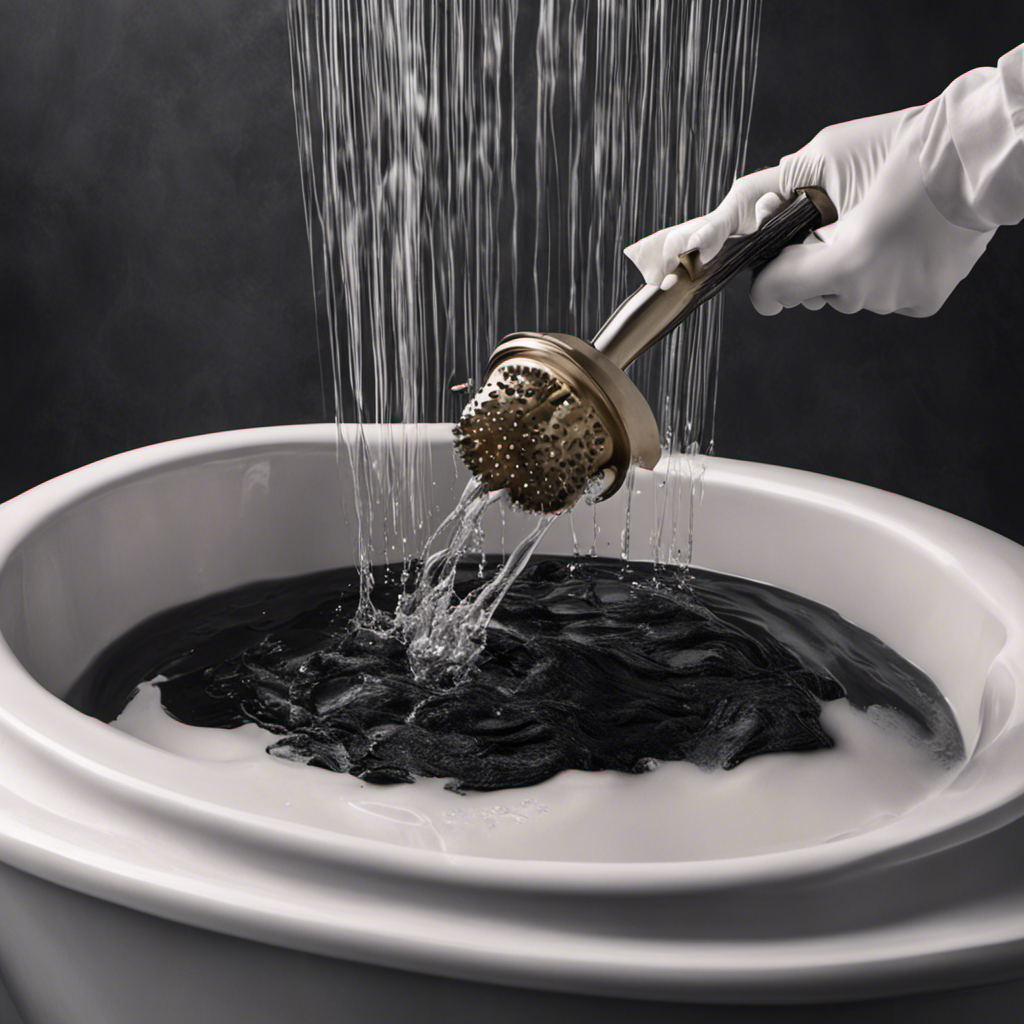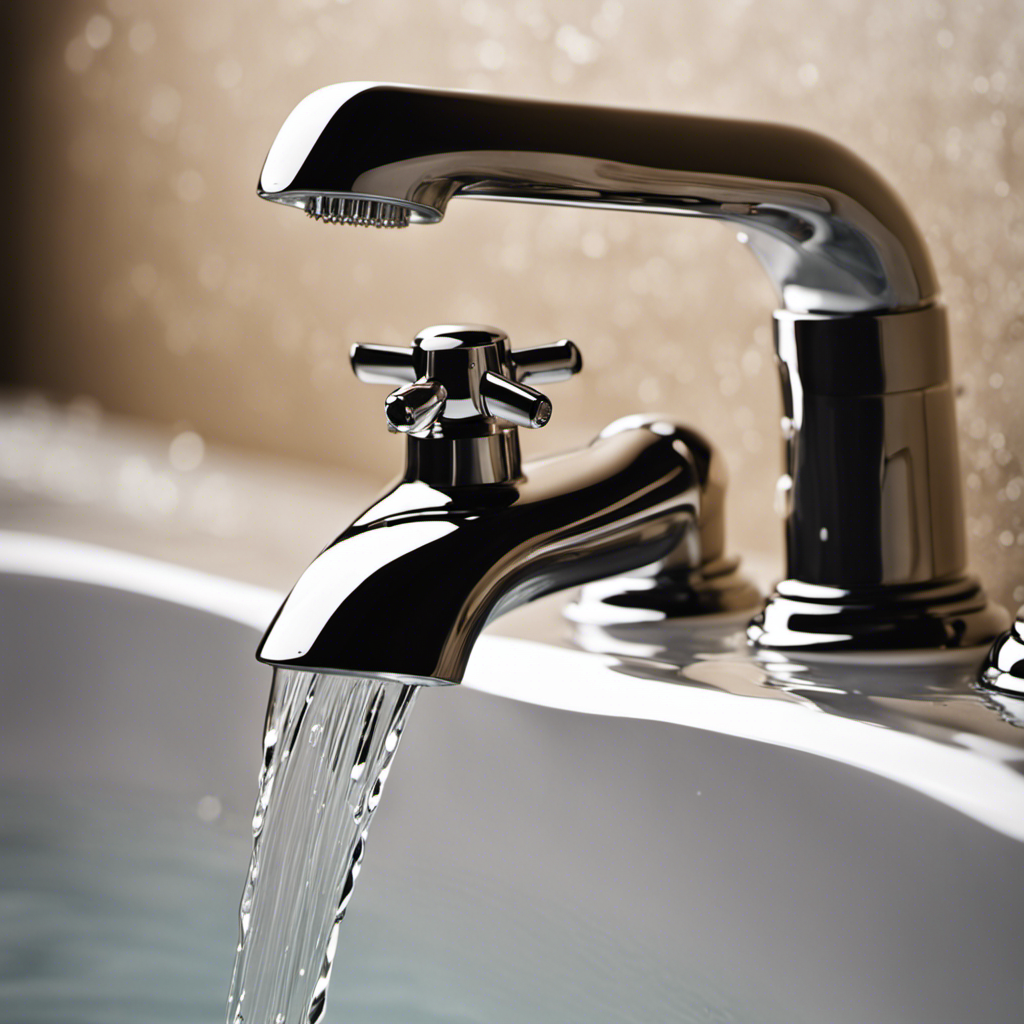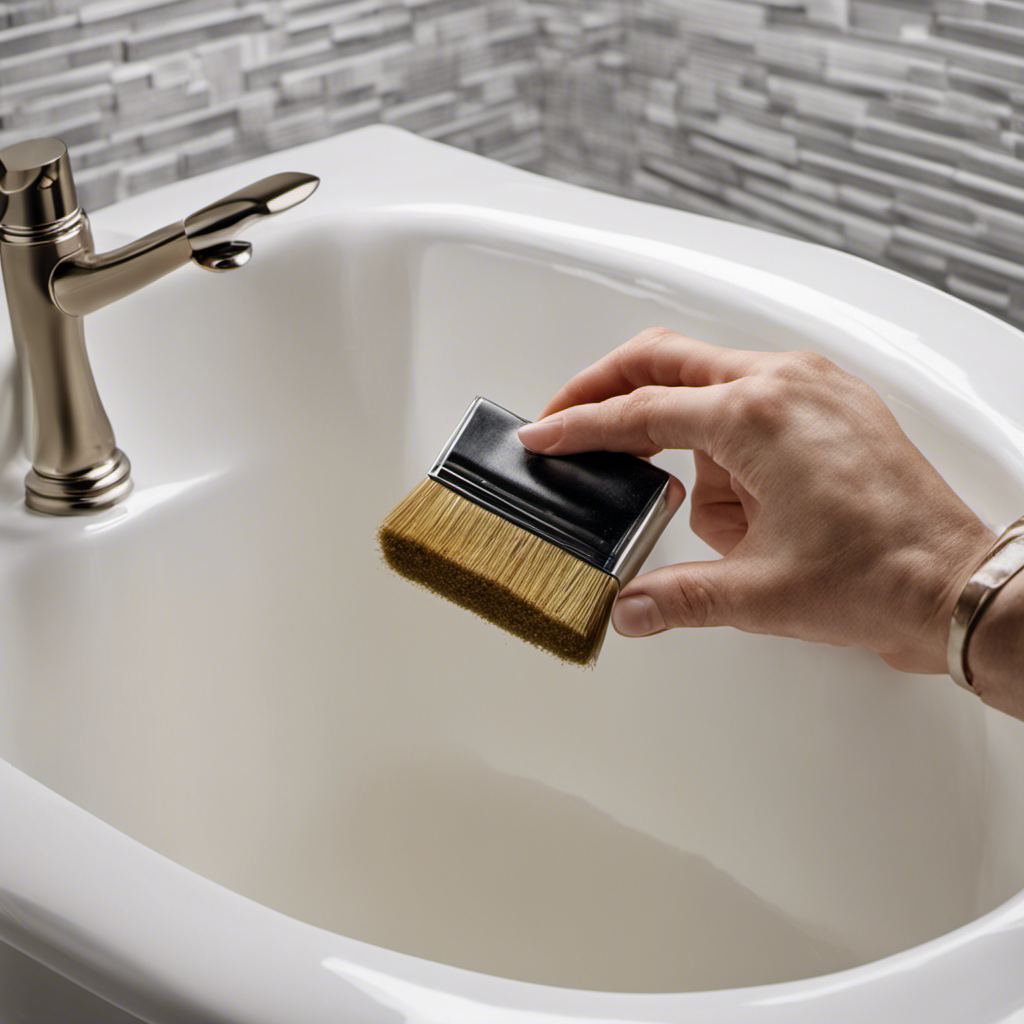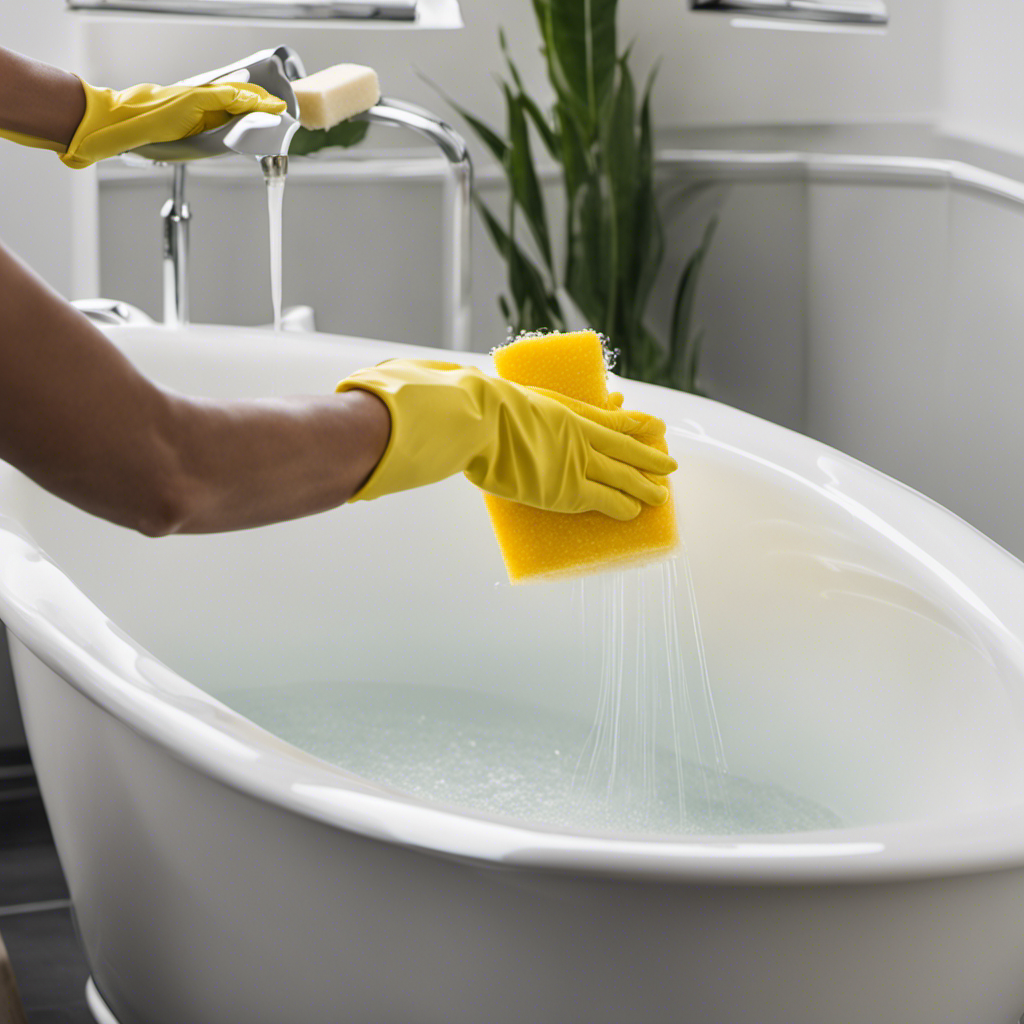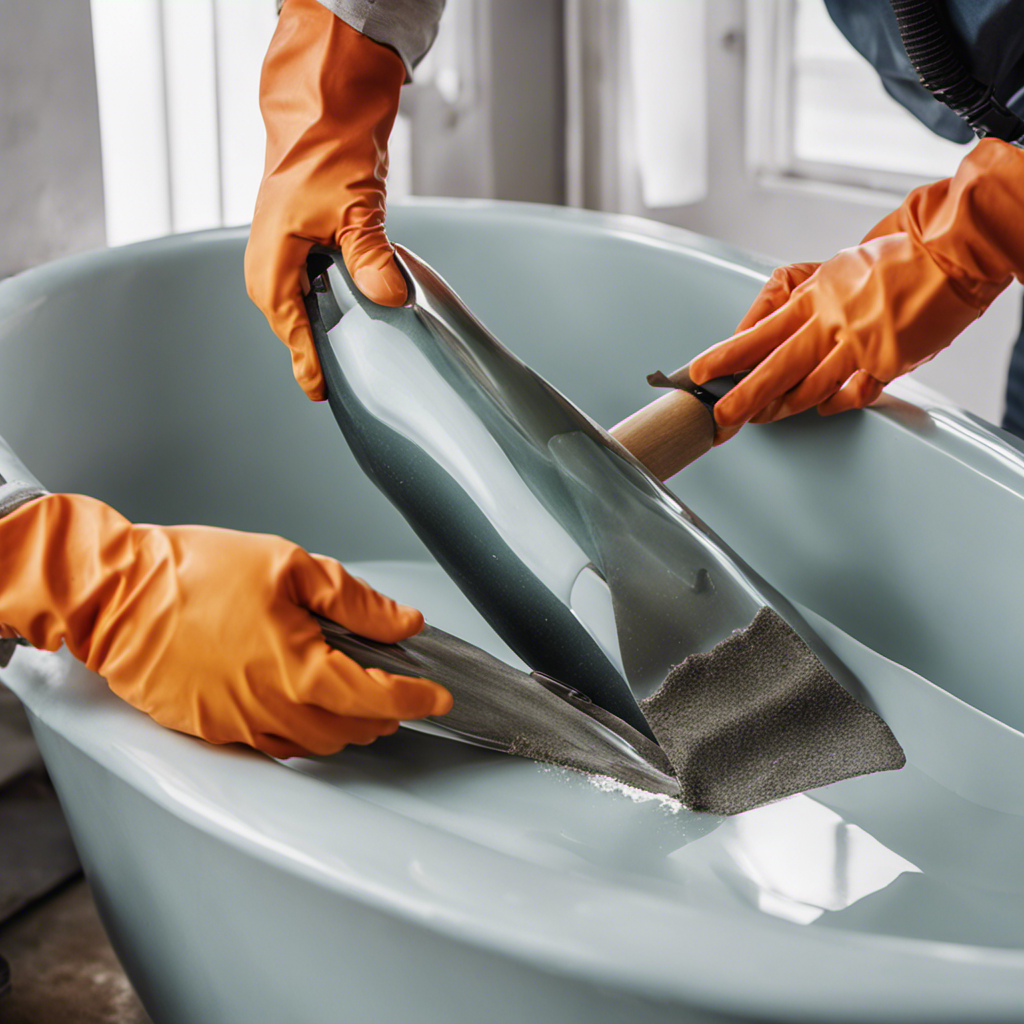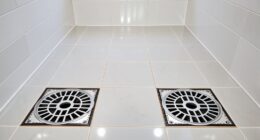Are you tired of dealing with a clogged bathtub? Frustration mounts as water refuses to drain, leaving you with a mess. But fear not! Unclogging your bathtub doesn’t have to be a daunting task.
By following a few simple steps, you can tackle the problem head-on and restore your bathtub to its former glory. In this article, we will guide you through the process of unclogging a bathtub, equipping you with the knowledge and tools necessary to conquer any clog that comes your way.
Key Takeaways
- Hair, soap scum, foreign objects, and residue can cause bathtub clogs.
- Tools like plungers, drain snakes, baking soda, vinegar, and hot water can be used to clear clogs.
- To prevent future clogs, use drain strainers, regularly clean the drain, and avoid pouring grease or food scraps down the drain.
- If DIY methods fail, calling a professional plumber can ensure proper resolution and prevent further damage to the plumbing system.
Understanding the Causes of Bathtub Clogs
Understanding the causes of bathtub clogs can help you prevent future blockages. By identifying common clog culprits and understanding drain anatomy, you can take proactive steps to keep your bathtub drain flowing smoothly.
Hair is one of the most common culprits of clogs. As it goes down the drain, it can accumulate and create a blockage. Soap scum and residue from shampoo and conditioner can also build up over time and restrict water flow. Additionally, foreign objects like toys or jewelry accidentally dropped into the drain can cause clogs.
Now that you know the common causes of clogs, let’s move on to identifying the tools you will need to effectively unclog your bathtub drain.
Identifying the Tools You Will Need
When it comes to unclogging a bathtub, having the right tools is essential. There are a few key pieces of equipment that you’ll need to have on hand.
Additionally, there are some commonly overlooked tools that can make the job easier and more efficient.
Essential Unclogging Equipment
To unclog your bathtub, grab a plunger and position it over the drain. Apply firm pressure and repeatedly push and pull to create suction and dislodge the clog. If this doesn’t work, don’t worry! There are alternative unclogging techniques you can try to overcome clog challenges. Take a look at the table below for some practical options:
| Technique | Method |
|---|---|
| Baking Soda and Vinegar | Pour a cup of baking soda followed by a cup of vinegar into the drain. Let it sit for 30 minutes, then flush with hot water. |
| Hot Water | Boil a pot of water and carefully pour it down the drain. The heat can help break up the clog. |
| Wire Hanger | Straighten a wire hanger and create a small hook at one end. Insert it into the drain and gently fish out any debris. |
| Dish Soap and Hot Water | Squirt dish soap into the drain, then pour hot water on top. Let it sit for a few minutes before rinsing with more hot water. |
| Wet/Dry Vacuum | Use a wet/dry vacuum to suck out the clog. Be sure to cover the vent to prevent a mess. |
Commonly Overlooked Tools
If you’re struggling to remove stubborn clogs, it’s worth considering some commonly overlooked tools.
While drain snakes are often relied upon for unclogging drains, there are other common household tools that can be just as effective. One such tool is a plunger. It can create suction and help dislodge the clog when used correctly.
Another tool to consider is a wire hanger. Straighten it out and create a small hook at one end. Insert it into the drain and maneuver it around to catch and pull out the debris causing the clog.
Additionally, a wet/dry vacuum can be useful. Use it to create suction and remove the clog.
These tools, when used properly, can offer similar benefits to drain snakes and help you unclog your bathtub effectively.
Removing Hair and Debris From the Drain
To prevent future clogs in your bathtub drain, there are a few key points to keep in mind.
First, avoid letting hair and debris go down the drain by using a drain strainer or stopper.
Second, regularly clean the drain by using common household tools such as a plunger or a drain snake.
Preventing Future Clogs
You can avoid future clogs by using a drain strainer in your bathtub. This simple tool will catch hair, debris, and other objects before they go down the drain and cause blockages. By regularly cleaning the strainer, you can prevent clogs in the long term.
Additionally, it is important to maintain the cleanliness of your drain. Once a week, pour boiling water down the drain to help flush away any accumulated gunk. You can also use a mixture of baking soda and vinegar to break down any buildup.
Avoid pouring grease, oils, or food scraps down the drain, as they can solidify and lead to clogs. By following these simple steps, you can keep your bathtub drain clear and prevent future clogs.
Common Household Tools
Using common household tools can be an effective way to prevent future clogs in your bathtub drain. By understanding the causes of clogs, you can take proactive steps to keep your drain clear and prevent costly plumbing repairs. Here are some common household tools that can help you maintain a clog-free bathtub:
| Tools | Purpose |
|---|---|
| Plunger | Clears minor clogs |
| Drain snake | Removes hair and debris |
| Zip-it | Eliminates hair clogs |
| Baking soda | Prevents buildup in the drain |
| Vinegar | Breaks down grease and residue |
Using a Plunger to Clear the Clog
If there’s a clog in your bathtub, grab a plunger to clear it. Using a plunger is one of the most effective unclogging techniques you can try. Here’s how to do it:
- Fill the tub with enough water to cover the rubber part of the plunger.
- Place the plunger over the drain and push down firmly to create a seal.
- Begin plunging vigorously up and down for about 15-20 seconds.
- Repeat this process a few times to dislodge the clog.
- Once the water starts draining, run hot water to flush away any remaining debris.
If the plunger doesn’t work, don’t worry. There are alternative methods that you can try. One of them is using a drain snake, which is perfect for stubborn clogs that the plunger can’t handle.
Using a Drain Snake for Stubborn Clogs
When it comes to effectively removing stubborn clogs in your drains, using a drain snake can be a game-changer. This handy tool not only helps you tackle tough blockages but also provides several benefits.
Drain snakes are flexible, allowing them to navigate through the twists and turns of your pipes, ensuring a thorough cleaning and preventing future clogs.
Effective Clog Removal Methods
To effectively remove a clog in your bathtub, you can try using a plunger or pouring a mixture of baking soda and vinegar down the drain. Here are some unclogging hacks and DIY bathtub drain cleaning methods that you can try:
-
Plunger: Use a plunger to create suction and dislodge the clog. Make sure to cover the overflow drain with a wet cloth to create a stronger seal.
-
Baking Soda and Vinegar: Pour half a cup of baking soda followed by half a cup of vinegar down the drain. Let it sit for about 30 minutes, then flush with hot water. The chemical reaction can help break down the clog.
-
Hot Water: Boil a pot of water and carefully pour it down the drain. The hot water can help dissolve grease and other substances that may be causing the clog.
-
Wire Hanger: Straighten out a wire hanger and create a small hook at one end. Insert it into the drain and use it to pull out any hair or debris that may be causing the clog.
-
Wet Vacuum: If you have a wet vacuum, you can try using it to suck out the clog. Just make sure to cover the vent to create a strong suction.
Benefits of Drain Snakes
One way to remove stubborn clogs from your drains is by using a drain snake. A drain snake, also known as a plumber’s snake, is a long, flexible tool that can be inserted into your drain to break up and remove clogs.
The benefits and advantages of using a drain snake are numerous. Firstly, it is a cost-effective solution compared to calling a professional plumber. With a drain snake, you can tackle clogs on your own, saving both time and money.
Secondly, using a drain snake is a non-toxic method, as it does not require the use of harsh chemicals that can be harmful to both the environment and your pipes.
Lastly, a drain snake is versatile and can be used on various types of drains, including sinks, showers, and bathtubs.
Overall, using a drain snake is a practical and effective way to unclog your drains.
Trying Natural Remedies to Unclog the Bathtub
You can try using baking soda and vinegar to naturally unclog your bathtub. It’s a simple and cost-effective DIY solution that can save you from calling a plumber.
Here’s how you can do it:
- Start by removing any standing water from the bathtub.
- Pour about half a cup of baking soda down the drain.
- Follow it with one cup of vinegar.
- Let the mixture sit for about 15 minutes.
- Finally, run hot water down the drain to flush out any remaining clogs.
This natural remedy works because the combination of baking soda and vinegar creates a fizzy reaction that helps break down the buildup in the pipes. It’s a safe and eco-friendly alternative to harsh chemical drain cleaners.
Give it a try before resorting to more drastic measures!
Using Chemical Drain Cleaners Safely and Effectively
Now that you’ve explored natural remedies to unclog your bathtub, let’s discuss using chemical drain cleaners safely and effectively. When using these cleaners, it’s important to take certain precautions.
First, always wear gloves and protective eyewear to avoid any contact with your skin or eyes. Make sure the bathroom is well-ventilated to minimize exposure to fumes. Additionally, carefully follow the instructions provided by the manufacturer and never mix different types of cleaners.
However, if you prefer to avoid chemical cleaners altogether, there are alternative methods to unclog your bathtub. For example, you can try using a plunger to create suction and dislodge the clog. Another option is using a drain snake or a wire coat hanger to physically remove the blockage. Additionally, a mixture of baking soda and vinegar can be used to dissolve the clog naturally.
These methods can be just as effective and are generally safer for your health and the environment.
Preventing Future Bathtub Clogs
To prevent future clogs in your bathtub, it’s essential to regularly clean the drain by removing any hair or debris that may accumulate. Here are some simple steps you can take to maintain drain cleanliness:
-
Use a drain strainer: Install a strainer over your drain to catch hair and other large particles before they go down the drain.
-
Flush with hot water: Once a week, pour a pot of boiling water down the drain to help dissolve any grease or soap buildup.
-
Use a vinegar and baking soda mixture: Once a month, pour half a cup of baking soda followed by a cup of vinegar down the drain. Let it sit for 15 minutes, then flush with hot water.
-
Avoid pouring grease down the drain: Grease can solidify and clog your pipes, so dispose of it in the trash instead.
-
Schedule regular professional drain cleaning: A professional plumber can use specialized tools to clear any buildup and ensure your drain is in good condition.
Calling a Professional Plumber for Help
If you’re experiencing persistent drainage issues, it may be necessary to call a professional plumber for assistance.
While there are DIY unclogging methods that can work for minor clogs, sometimes the problem requires the expertise of a plumber.
A professional plumber has the knowledge, experience, and tools to diagnose and fix more complex clogging issues. They can identify the underlying cause of the clog and provide a long-term solution.
Calling a professional plumber not only saves you time and effort but also ensures that the clog is properly resolved, preventing further damage to your plumbing system.
Troubleshooting Common Clog Issues
Sometimes, even with regular maintenance, clogs can still occur in your bathtub. Before calling a professional plumber, try troubleshooting common clog issues yourself. Here are some practical tips to help you unclog your bathtub:
-
Use a plunger: Create a tight seal with the plunger and vigorously plunge up and down to dislodge the clog.
-
Try a drain snake: Insert the snake into the drain and twist it to break up the clog.
-
Use a mixture of baking soda and vinegar: Pour half a cup of baking soda followed by half a cup of vinegar into the drain. Let it sit for an hour, then flush with hot water.
-
Remove and clean the overflow plate: Unscrew the plate and clean any debris or hair that may be causing the clog.
-
Check the trap: Unscrew the trap and remove any blockages.
Frequently Asked Questions
How Do I Prevent Future Bathtub Clogs?
To prevent future bathtub clogs, incorporate preventive measures and establish a regular maintenance routine. By taking simple steps like using a drain strainer and regularly cleaning the pipes, you can avoid future clogging issues.
Can I Use Chemical Drain Cleaners to Unclog the Bathtub?
Using chemical drain cleaners to unclog your bathtub may seem like a quick fix, but it can actually cause more harm than good. Instead, focus on regular bathtub maintenance to prevent clogs in the first place.
What Are Some Natural Remedies to Unclog a Bathtub?
To unclog a bathtub, try using home remedies or DIY solutions. These can be effective and cost-friendly alternatives to chemical drain cleaners. Some options include using a plunger, baking soda and vinegar, or a drain snake.
Should I Call a Professional Plumber for Help With a Stubborn Clog?
If your clog is stubborn, don’t hesitate to call a professional plumber. They have the expertise and tools to tackle even the toughest clogs. However, if you’re feeling adventurous, DIY methods can be worth a shot.
What Are Some Common Issues That Can Cause Bathtub Clogs?
Common causes of bathtub clogs include hair, soap scum, and foreign objects. To unclog your bathtub, try using a plunger or a drain snake. These DIY methods are effective and can save you money.
Conclusion
So, there you have it! By following the steps outlined in this article, you should now have all the knowledge you need to effectively unclog your bathtub.
Remember to always start by understanding the causes of the clog and gathering the necessary tools.
Whether it’s removing hair and debris, using a plunger, or employing a drain snake, there are multiple methods at your disposal.
Additionally, be sure to use chemical drain cleaners safely and consider preventive measures to avoid future clogs.
If all else fails, don’t hesitate to contact a professional plumber for assistance.
Happy unclogging!
